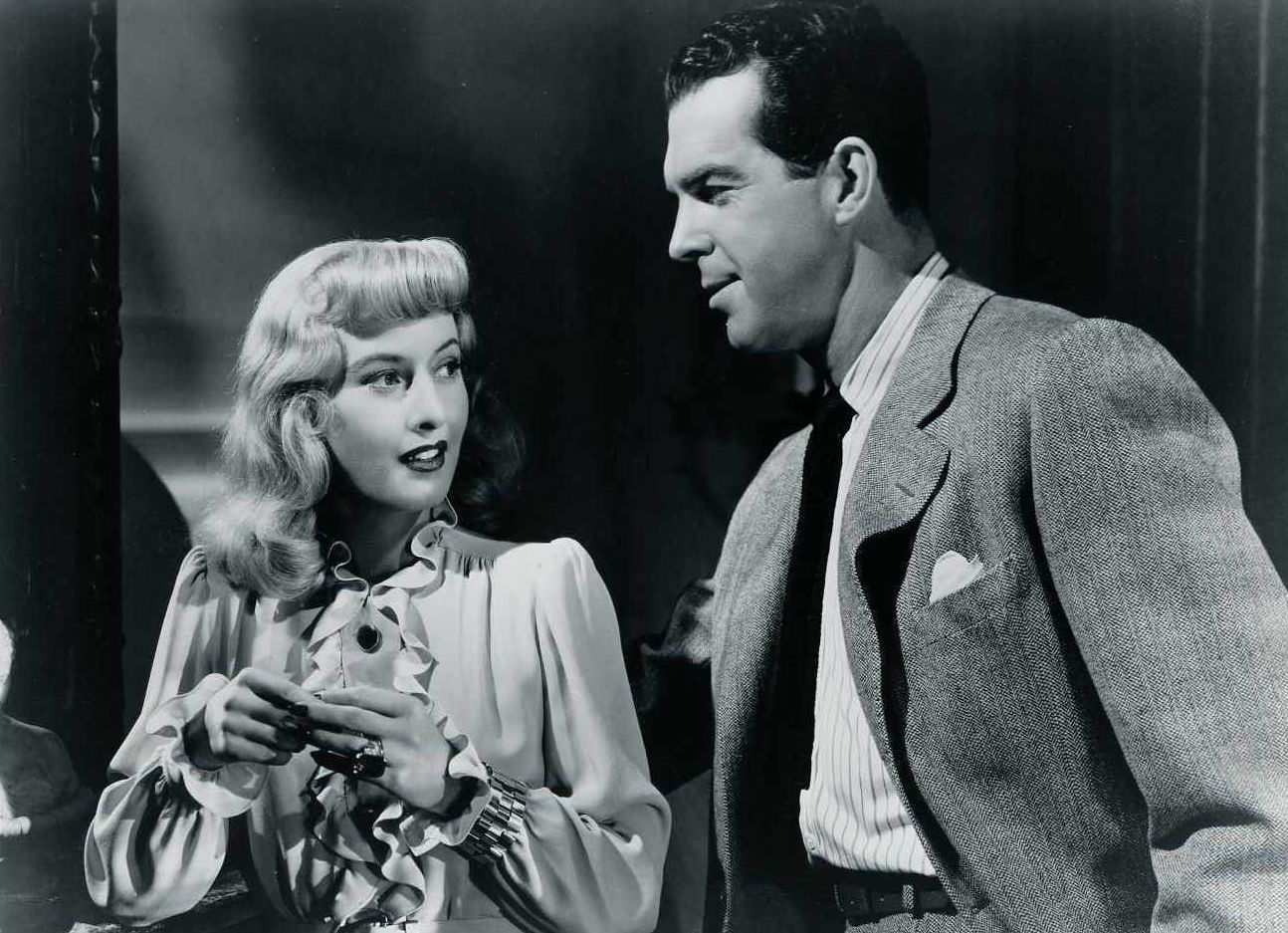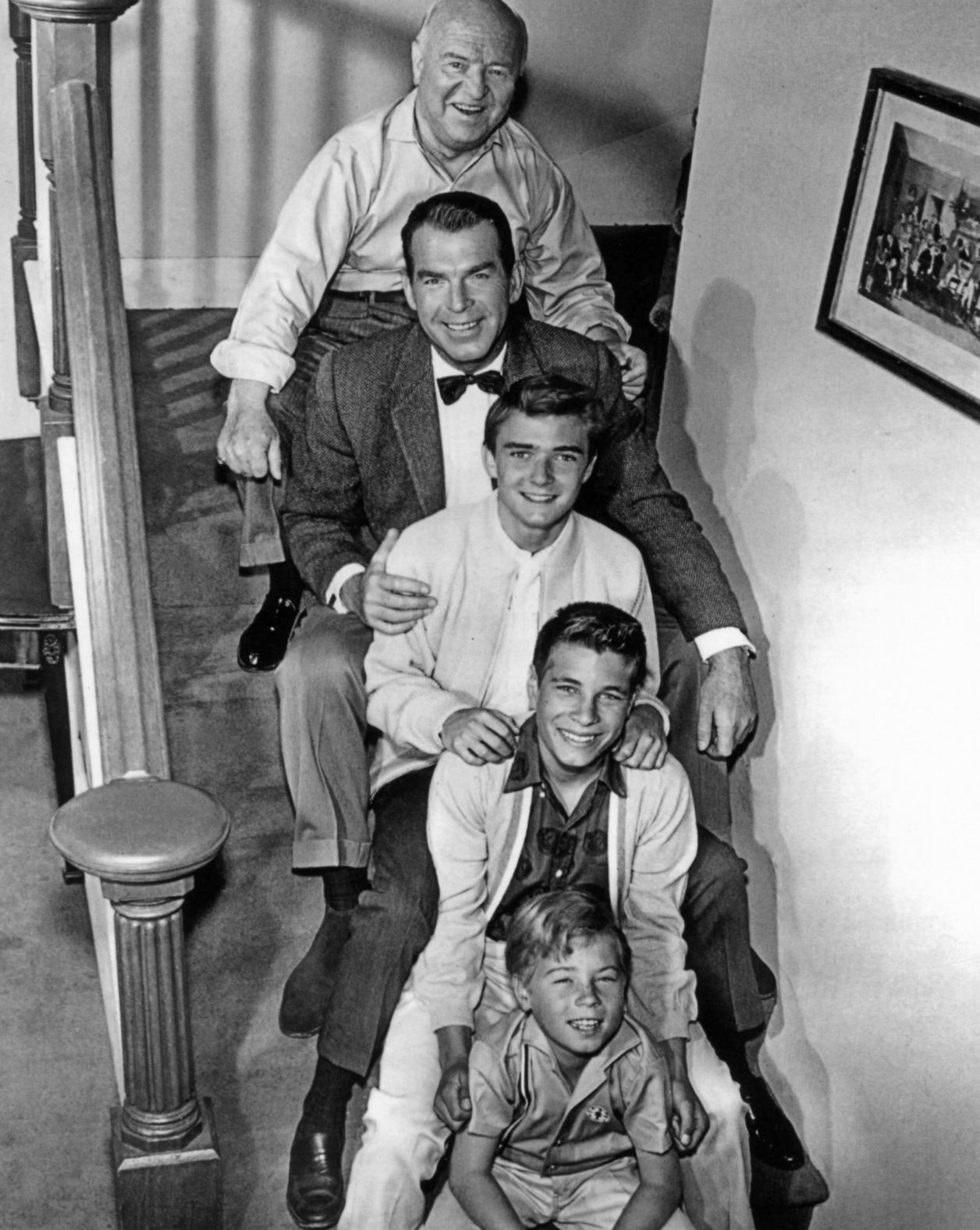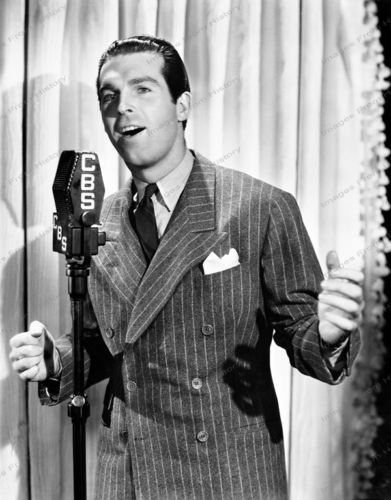Happy Birthday, Fred MacMurray!
Posted by Ivan G. Shreve, Jr. on Aug 30th 2016
With his first credited film appearance in 1935’s Grand Old Girl, it didn’t take long before Frederick Martin MacMurray—born in Kankakee, IL on this date in 1908—became one of the silver screen’s most personable motion picture stars. Fred MacMurray specialized in romantic leads, notably in such screwball comedies as The Gilded Lily (1935) and Too Many Husbands (1940) …but he also received opportunities to extend his acting range with darker performances in the likes of Double Indemnity (1944). When MacMurray began to age out of playing leading men, he continued his career as the easily recognizable Dad in both a slew of Walt Disney comedies and a long-running television sitcom, My Three Sons.
Fred MacMurray may not have had a lot of acting experience when he started out in pictures…but show business undeniably ran through the family bloodline; young Fred was born in Kankakee while his concert violinist father was on tour. (MacMurray’s aunt was actress Fay Holderness, who had performed in vaudeville.) Both of his parents were Wisconsin natives, and when Fred was two, the family moved back to the Badger State, settling in Madison and then Beaver Dam (the place of his mother’s birth). Pa and Ma MacMurray separated when Fred was only five, and some have speculated that the experience encouraged him to become a model father (both off and onscreen) in later years. He graduated from high school with an impressive record in athletics, and an American Legion scholarship paved the way for his enrollment at Waukesha’s Carroll College.
MacMurray never graduated from Carroll, however. His interest in the saxophone at an early age had grown by leaps and bounds as he got older, and while attending college he started his own three-piece ensemble, Mac’s Melody Boys. Music eventually become Fred’s main interest, and over the years he did quite a bit of sax-wailing in dance and vaudeville bands across the country. Arriving on the West Coast, he joined up with an aggregation known as the California Collegians; they performed extensively in vaudeville until they were asked to appear in a 1930 Broadway revue entitled Three’s a Crowd. (That show featured Libby Holman, Clifton Webb…and some comic named Fred Allen.) The Collegians were also featured in the 1933-34 Broadway hit Roberta as the band for “Huckleberry Haines”—played by none other than Bob Hope.

Though Fred MacMurray had appeared in extra and bit roles in movies before signing a seven-year contract with Paramount, it was The Gilded Lily that made him a performer to watch. His co-stars in that film were Ray Milland (also a Paramount newcomer) and Claudette Colbert—Colbert would eventually become MacMurray’s most frequent leading lady, appearing with him in six additional feature films: The Bride Comes Home (1935), Maid of Salem (1937), No Time for Love (1943), Practically Yours (1944), The Egg and I (1947), and Family Honeymoon (1948). In addition, Fred made four films with Carole Lombard: Hands Across the Table (1935), The Princess Comes Across (1936), Swing High, Swing Low (1937), and True Confession (1937). Other silver screen favorites to appear alongside MacMurray include Katharine Hepburn (Alice Adams), Marlene Dietrich (The Lady is Willing), Rosalind Russell (Take a Letter, Darling), and Joan Crawford (Above Suspicion).
By 1943, Fred MacMurray was one of the motion picture industry’s highest-paid actors (he cleared $420,000 that year, making him the fourth highest-paid American). Typecast in “nice guy” roles, it was writer-director Billy Wilder who decided to besmirch Fred’s clean-cut image by choosing him to play insurance agent Walter Neff in Double Indemnity (1944), a film noir classic in which he helps murder Barbara Stanwyck’s husband so she can collect the insurance. Indemnity provided a much-needed dimension to MacMurray’s acting, and Wilder would call upon him again in 1960, making him an even bigger scoundrel as the unscrupulous Jeff Sheldrake in the Academy Award Winner for Best Picture, The Apartment. Those two performances, as well as villainous turns in Pushover (1954) and The Caine Mutiny (1954), clearly showed that Fred had far more depth as an actor than his previous roles had allowed him to demonstrate.
At the height of his movie fame, Fred MacMurray often promoted his films through the medium of radio. He made the rounds on many an anthology series, among them Family Theatre, The Gulf/Lady Esther Screen Guild Theatre, Hallmark Playhouse, The Lux Radio Theatre, and Screen Director’s Playhouse. MacMurray guested on the likes of Hollywood Hotel and Suspense; joshed with Edgar Bergen, Bob Hope, and Martin & Lewis; and did his bit for the war effort on Command Performance, G.I. Journal, and Mail Call. Fred’s most notable radio success was a syndicated series, Bright Star, in which he and Irene Dunne (who had appeared opposite MacMurray in Invitation to Happiness [1939] and Never a Dull Moment [1950]) starred. Dunne was Susan Armstrong, the owner and editor of the fictional Hillside Morning Star, while Fred played her ace reporter George Harvey. The 1952-53 series centered around Susan’s struggles to keep the newspaper going and included Elvia Allman (as Susan’s housekeeper) and announcer Harry von Zell in the cast.

As the 1950s came to a close, good roles came few and far between for Fred. He started to become a fixture in Westerns, like Day of the Badman (1958) and Good Day for a Hanging (1959). A modest little comedy film from the Walt Disney Studios would prove to be the career reboot that he needed. Though he resisted appearing in The Shaggy Dog (1959) at first, the movie became one of that year’s biggest box office hits and led to additional Disney work in vehicles like The Absent-Minded Professor (1961—and its sequel, 1963’s Son of Flubber), The Happiest Millionaire (1967), and Charley and the Angel (1972). Curiously, Disney had originally pitched The Shaggy Dog as an idea for a series to ABC (who wanted the studio to duplicate its small screen success with Disneyland and Zorro), but the network nixed the idea. Still, Shaggy Dog would be a springboard for a successful situation comedy that premiered on that same network in the fall of 1960.
On the television sitcom My Three Sons, Fred essayed the role of Steve Douglas, a widower trying to bring up his three kids (Tim Considine, Don Grady, Stanley Livingston) with the help of grandfather Michael Francis “Bub” O’Casey (William Frawley). Movie actors still shunned TV at this time, but what sold MacMurray on the series was the working conditions: he was only required to work 65 days a year, a practice that soon became known in the industry as “the MacMurray method.” All Fred had to do was change his cardigan for each scene shot in that time frame…and even then, a few of the show’s episodes featured him “away on business.” The show was a big hit for ABC, and when the network couldn’t commit to filming the show in color after five seasons, Sons moved to CBS for an additional seven years. (There were a slew of casting adds and deletions along the way, too.)

After My Three Sons came to an end, Fred MacMurray appeared in only a handful of films and TV movies before deciding that he’d had enough (his final performance was in 1978’s The Swarm, a picture that should have killed the careers of everyone involved). He once described himself as being “lazy in spurts—I’d as soon go fishing or play golf.” That’s how he lived out his retirement (he also liked painting and cooking) until his passing in 1991 at the age of 83. To celebrate Fred’s birthday, Radio Spirits encourages you to check out The Funny Fifties, a superb collection of Edgar Bergen (and Charlie McCarthy) shows that features an October 18, 1953 broadcast with our birthday boy and Anita Gordon. Mr. MacMurray’s signature series, Bright Star, is also available in a 4-CD set containing eight vintage shows.

